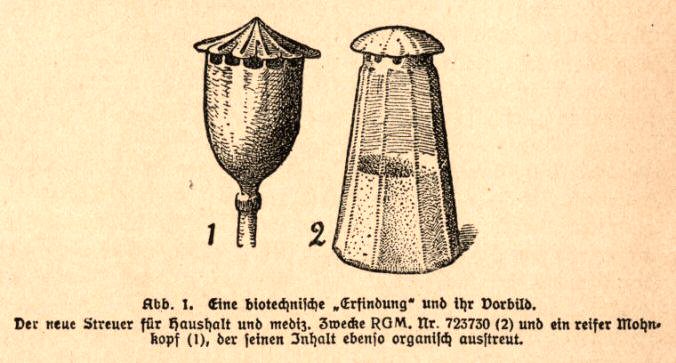
This week’s update centers around a single book, the story of how I got it, what I learned from it, and what I’m now doing with it. The book is called „Die Pflanze als Erfinder“ (The Plant as Inventor), and was written in 1920 by Austro-Hungarian Botanist Raoul Heinrich Francé. In it, Francé lays the ground-thoughts for what he called, and we today still call, Biotechnics (Biotechnik), the study of the structural machinery (seed dispersal, water-pumping, heating, etc.) developed by plants.
I came upon the existence of this book through my biocentrism class, in which we were studying early 20th century architectural trends. Specifically, we were reading about Mies van der Rohe (and other Bauhaus architects and artists) and their particular influences from the sciences. Although van der Rohe’s buildings (many of which are in Chicago, by the way) are usually discussed in terms of the relationship between function and form, it was discovered that van der Rohe possessed almost 40 of Francé’s books in his personal library, Die Pflanze als Erfinder being among them. This discovery lead architectural historians to begin looking at the possible connections between Francé’s thinking about the relationship between organism and environment (in which all structural elements of organisms derive directly through environmental pressures) and van der Rohe’s functionalist architecture.
After reading about this budding area of research, I decided that I wanted to see this book for myself. I searched around online and found a few scanned PDFs of it, but generally prefer actual books, so decided to check the University of Chicago’s Library System to see if we had a copy of it. As it turned out, we did, but it was in the basement of the dreaded Crerar Science Library, a building which strikes fear into the hearts of all UChicago Students because of its cold, brutal seriousness. I went to the library, descended the stairs into the Dewey Decimal section (the rest of the University uses the Library of Congress standard for library organization) in the basement, looked around for the book, but couldn’t seem to find it. I showed the call-number to the student sitting behind the reference desk, who told me that he was going to have to get his supervisor to help me, because the book was under lock-and-key. Ten minutes later, after following the supervisor into the literal bowels of the library (where they don’t seem to bother turning on lights), I had the book in my hand: an actual first-edition 1920 copy of Die Pflanze als Erfinder!
When I opened the book, I found the original receipt of sale tucked away in it from when the University purchased the book—it seemed like no-one had ever checked it out before! More out of curiosity than desire, I asked if I could check the book out, and, astoundingly, the librarian said: „Why not?“ I’m amazed at how cavalier our library system is about allowing students to check-out books. All of the European University Libraries I visited over the last year wouldn’t even let you take-home a Harry Potter book, yet ours here at Chicago is willing to let me read first-editions in my bathtub. Crazy.
Most scholarship surrounding the book (of which there is relatively little) focuses on its relationship to architectural trends of the early 20th century, and, in my opinion, misses many of the other ideas Francé lays out in defining Biotechnics. Alongside his descriptions of how he became inspired by plants in creating several of his patented inventions, he lays out an entire theory of the cosmos: how humans relate to nature, what it means to abstract ideas into numbers, how universal laws of nature drive technological development in the same ways they drive biological evolution. I think this work deserves more attention, and I’m currently working on translating parts of it into a more readable Standard-German-Text format, so that it can be more readily available online.